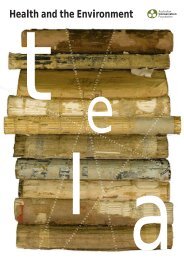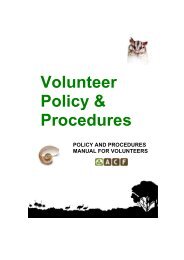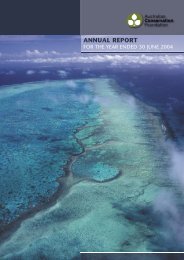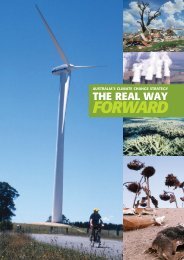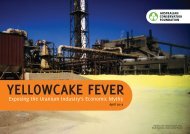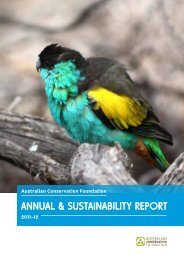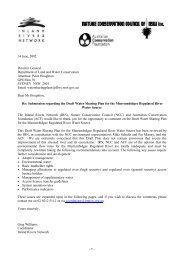Protecting Western Australia's Big Blue Backyard - The Pew ...
Protecting Western Australia's Big Blue Backyard - The Pew ...
Protecting Western Australia's Big Blue Backyard - The Pew ...
- No tags were found...
You also want an ePaper? Increase the reach of your titles
YUMPU automatically turns print PDFs into web optimized ePapers that Google loves.
CURRENT AFFAIRSOcean waters are never still. <strong>The</strong> rise and fall ofwaves, the ebb and flood of tides, the ups anddowns of canyon waters, the spirals in eddies andthe streaming of currents—ocean water is alwayson the move and marine life goes with the flow.In the world of ocean currents there is nothingquite like the Leeuwin Current. It is the only majorcurrent in the world that flows south along theeastern side of an ocean basin—all othersflow north.By heading south, the Leeuwin Current has createda marine and coastal environment in <strong>Western</strong>Australia that is very different to that provided bythe cool and northerly currents off the west coastsof Africa and South America. <strong>The</strong> Leeuwin Currentmakes <strong>Western</strong> Australia’s marine environment avery special place in the world.Currents like the Leeuwin transport marine lifearound the oceans of the world. <strong>The</strong>y form inresponse to the effects of solar heating, wind,gravity and the Earth’s rotation, and are influencedby variations in atmospheric pressure, watertemperature, salinity and sea floor shape.Coastal climates are affected by oceancurrents—warm currents, such as the LeeuwinCurrent, lead to increased evaporation and higherrainfall along nearby coasts, while evaporation andrainfall are lower on coasts bordered bycold currents.Fisheries can be enhanced by ocean currents.Equator-bound, west-coast currents such as theBenguela off Africa and the Humboldt off SouthAmerica bring upwellings of cool, nutrient-richwater to the surface. This drives marine plantproduction and attracts enormous amounts ofsurface-dwelling fish that are targeted by someof the world’s major fisheries. In contrast, withno major northerly flowing surface currents andnutrient-poor marine waters, Australia ranks fiftiethin world fisheries production even though we havethe third-largest marine area in our care.<strong>The</strong>re are six main currents in the Kalbarri toEucla region—the Leeuwin Current, the LeeuwinUndercurrent, the <strong>Western</strong> Australian Current, theFlinders Current and the seasonal and inshoreCapes and Creswell currents. <strong>The</strong>y flow in differentdirections and with varying strengths, but each hasits own special influence on the region’s marineenvironment and marine life. By far the mostimportant of these is the Leeuwin Current.<strong>The</strong> Leeuwin Current is like the southbound lanesof a freeway and marine life is like the traffic.<strong>The</strong> lower deck is the Leeuwin Undercurrent, whilebreakaway eddies are the exits and on-ramps.During summer the northbound traffic of theCapes Current is driven by south-east winds offcapes Leeuwin and Naturaliste. Once aroundCape Leeuwin, the Leeuwin freeway is eastbound,while the cooler Flinders Current carrieswestbound traffic.TAKING THE TROPICS SOUTH<strong>The</strong> Leeuwin Current begins its long and importantjourney in the tropical waters surrounding theIndonesian islands. <strong>The</strong> warm waters around theislands are less dense and lower in salinity than thecooler waters of southern Australia. <strong>The</strong> result is asea level around the islands that is 50 centimetreshigher than in the south. In response, the LeeuwinCurrent does what water normally does—it flows‘downhill’.<strong>The</strong> strength of the Leeuwin Current in the IndianOcean is variable from year to year and season toseason—it is at its strongest in autumn and winter.<strong>The</strong> current’s variations in strength are related tomajor ocean processes in the Pacific Ocean, whichare linked to the Indian Ocean through TorresStrait and the waters across northern Australia.During what are called El Niño events, differencesin atmospheric pressure push sea level higher onthe eastern side of the Pacific and reduce sea levelaround the Indonesian islands. At these times thesea level gradient along the west coast is reducedand the Leeuwin Current is weaker.With La Niña events, sea level is relatively higheron the western side of the Pacific and also aroundthe Indonesian islands. When this occurs thesea level gradient is steeper and the LeeuwinCurrent stronger.From Indonesia the Leeuwin Current carries warmand clear tropical water down the west coast of<strong>Western</strong> Australia, around Cape Leeuwin, alongthe state’s south coast, across the Great Australian<strong>Big</strong>ht, finally ending on the western shores ofTasmania. At 5500 kilometres, it is the world’slongest continuous coastal current.Tropical fish larvae and coral polyps, whales,tuna and other marine life are either taken orgo along for the ride. <strong>The</strong> world’s largest marineturtle, the endangered leatherback turtle, driftswith the current while surface-feeding on jellyfish.It can also swim away from the current and diveto depths of 1200 metres on the continental slope.As water temperatures rise with climate change,the Leeuwin Current could bring more tropicalcoral species into the region and carry them evenfurther south. This is the conclusion of a scientificstudy of fossil evidence by the ARC Centre ofExcellence for Coral Reef Studies. According tothe analysis, tropical coral species could movesouth to avoid coral bleaching and coral diseasesassociated with warmer water in the tropics.<strong>The</strong>re are suitable areas of shallow and clear wateroff the west coast of <strong>Western</strong> Australia wherethese climate refugees could re-establishthemselves as southern waters also warm withclimate change. <strong>The</strong> Centre of Excellencebelieves these areas need to be protected andwell managed to provide a sanctuary for thesetravelling coral species.CREATING A UNIQUE MARINE REGIONAs it rounds Shark Bay the Leeuwin Current entersthe Kalbarri to Eucla region. About 200 kilometresto the west are the recently discovered wrecksof HMAS Sydney II and the German cruiser, theKormoran, both sunk in battle with one anotherin 1941.On passing Kalbarri, the Leeuwin Current is lessthan 100 kilometres wide, barely 300 metres deepand travelling at about two kilometres per hour.From here its journey will have a profound effecton the region’s marine life, climate and people.<strong>The</strong> Leeuwin Current’s warm waters moderatewinter temperatures and encourage higher annualrainfalls than would normally occur here. It bringstropical species south where they are shaken andstirred with subtropical and temperate species ina remarkable cocktail of marine life. <strong>Blue</strong> whalesand southern right whales from cooler waters sharethe region’s ocean with tropical short-finned pilotwhales, and striped and spinner dolphins.<strong>The</strong> Leeuwin Current’s influence, the region’sisolation and a history free of major environmentaldisturbance over geological time have createda marine environment unlike any other. Marineplants and animals have evolved here in theirown ways, making the best of a unique westcoast environment. Most of them are not foundanywhere else in the world, making this regionglobally unique.<strong>The</strong> Current’s southerly movement preventsupwellings of nutrients from the sea floor.This suppresses blooms of phytoplankton (tinyplants) and zooplankton (tiny animals). In turn,this limits the abundance of surface-dwelling fishthat target the plankton for food.With only a few small river discharges, nutrientlevels are very low and the warm waters crystalclear. Seaweeds and seagrasses thrive in depthsmuch greater than usual—extensive seagrassbeds on the west coast are found in water atleast 30 metres deep. <strong>The</strong>se are critical feedingand nursery areas for marine species targeted bycommercial and recreational fishers.<strong>The</strong> low level of nutrients in surface waters andthe water column also means that marine speciesliving on or near the sea floor are more numerousand most are invertebrates, not fish. As a result,the region’s commercial fisheries largely targetbottom-dwelling crustaceans and molluscs:western rock lobster, deep sea crabs, prawns,abalone and scallops.Upward and downward spirals of water breakoff the Leeuwin Current at the Abrolhos Islands,Jurien Bay, Rottnest Island and Cape Naturalisteand assist the region’s upwellings. <strong>The</strong>se eddiescan also carry marine life off the continental shelf,out into the Indian Ocean and possibly back again,fuelling food supplies for open-ocean species.Where localised upwellings of nutrients do occur,usually at the heads of submerged canyons etchedin the edge of the continental shelf, they becomeoases for larger marine life. Between these oases,marine animals and plants have adapted to anenvironment low in nutrients but with deeplight penetration.<strong>The</strong> nutrients raised by the upwellings are amixture of materials from marine animals andplants that have died and sunk to the seabed,and plants, nitrogen, phosphorous and silicaflowing from rivers.Nutrients are just what phytoplankton andzooplankton need for growth, and smallsurface-dwelling fish such as pilchards, herring,sprat, anchovies, red bait and jack mackerel gatherin vast numbers to feast on them. In turn theyare eaten by southern bluefin tuna and spanishmackerel. <strong>The</strong>se large and mobile predatorssurvive on limited food resources while travellingbetween upwellings.<strong>The</strong>re is still much scientists do not know aboutthe Leeuwin Current or the impact climate changemight have on its nature and strength.However, there is no doubt that the LeeuwinCurrent has brought together a unique andinternationally significant mix of marine lifein <strong>Western</strong> Australia’s big blue backyard.14<strong>The</strong> Leeuwin Currentmakes <strong>Western</strong> Australia’smarine environment a veryspecial place in the world15



